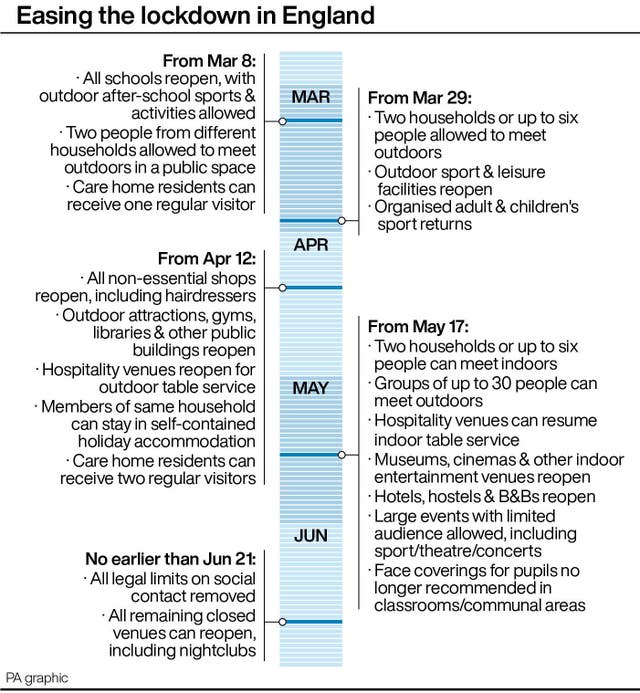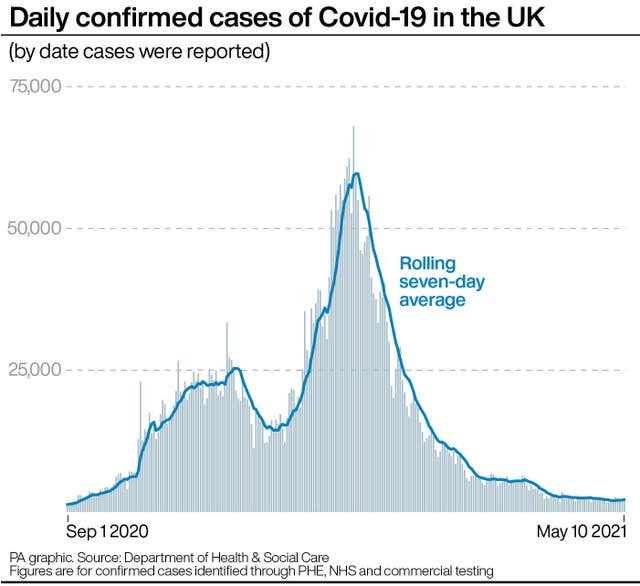PM sets England on road back to normality in confirming May 17 lockdown easing
The move came as the Covid-19 alert level in the UK was downgraded after a ‘consistent’ fall in cases, hospital admissions and deaths.

People in England will be able to hug loved ones, dine in restaurants and go on holiday abroad from next week in a “considerable step on the road back to normality”, Boris Johnson has confirmed.
The move to the next stage of the road map out of lockdown on May 17 came as the Covid-19 alert level in the UK was downgraded after a “consistent” fall in cases, hospital admissions and deaths.
Scottish First Minister Nicola Sturgeon will give an update on restrictions on Tuesday, having indicated Scotland could be granted renewed freedoms along similar lines from Monday.
The Prime Minister set out a new approach to tackling the virus, giving people greater responsibility for their own choices on whether to observe social distancing with friends and family.
“Today we are taking a step towards that moment when we learn to live responsibly with Covid, when we cease eventually to rely on detailed Government edicts and make our own decisions,” he said.
Confirmation that England would move to step three on the road map came from Mr Johnson at a Downing Street press conference after a Cabinet meeting to sign off the change.
The Prime Minister said: “This unlocking amounts to a very considerable step on the road map to normality and I am confident that we will be able to go further.”

The road map remained on track for the next stage on June 21 and Mr Johnson promised that later this month the Government would set out “what role there could be – if any – for certification and social distancing”.
The Government has been reviewing whether Covid status certification, recording whether people have had a vaccine or negative test result, could be used to help open up businesses and Mr Johnson’s comments could be a hint they are no longer a priority.
Mr Johnson said current data indicated it might be possible to scrap the “one-metre plus” rule, which would greatly increase flexibility for businesses to increase capacity.
As part of the May 17 changes, people will be given the choice whether to remain two metres from family or friends, meaning they can once again hug and shake hands.
“This doesn’t mean that we can suddenly throw caution to the winds. We all know that close contacts such as hugging is a direct way of transmitting this disease,” Mr Johnson said.
“So I urge you to think about the vulnerability of your loved ones.”
Officials suggested people should consider getting tested for coronavirus before hugging and wear face masks or ensure a room is well ventilated before ditching social distancing measures.

From May 17:
– People will be able to meet outdoors in groups of up to 30.
– People will be able to meet indoors in groups of six, or two households.
– Pubs and restaurants will be able to serve customers indoors, although they will be limited to table service.
– Cinemas, museums, theatres and concert halls will be allowed to reopen although there will be capacity limits on large events.
– The “stay in the UK” restriction will lift and people will be able to travel to “green list” countries such as Portugal, although they are still being advised not to go to destinations on the amber list.
– Up to 30 people will be allowed at weddings, although dancing will still not be allowed, and the cap on the number of mourners attending funerals will be lifted, in line with the safe capacity of the venue.
– Secondary school pupils will no longer be told to wear face masks in class and communal areas.
– University students will return to campus for in-person lectures.
The easing of restrictions came after the UK’s senior medics said the Covid-19 alert level should be lowered from level 4 to level 3, meaning that while the virus is in general circulation, transmission is no longer deemed to be high or rising exponentially.

But England’s chief medical officer Professor Chris Whitty urged particular caution around the Indian variant which has been detected in increasing numbers in the UK.
From a low level “it has gone up very sharply”, he said, warning that it was possibly more transmissible than the Kent variant which swept across the UK in the winter.
But “at this point in time our view is that it is less likely to be able to escape vaccination than some of the other variants”.
Up to May 5, 520 confirmed or probable cases of the Indian strain had been identified, an increase of 318 in a week.

The latest figures showed:
– Up to May 9 35,472,295 people have had a first dose of vaccine, a rise of 100,626 on the previous day, while 17,856,550 have also had a second doses, an increase of 187,171.
– A further four people died within 28 days of testing positive for Covid-19 as of Monday, bringing the UK total to 127,609.
– The figures on the Government dashboard showed none of the new deaths reported on Monday were in England, Scotland or Northern Ireland but there is often a lag in data following a weekend.
– The Government also said that, as of 9am on Monday, there had been a further 2,357 lab-confirmed cases in the UK, bringing the total to 4,437,217.
Meanwhile, BioNTech has said its Covid-19 vaccine with Pfizer does not need to be tweaked to tackle variants of the virus currently in circulation.
But it said it has a strategy to “address these variants should the need arise in the future”.
In further positive news, analysis by Public Health England found a single dose of the AstraZeneca vaccine reduces the risk of death with Covid-19 by approximately 80% – and two doses of Pfizer cut it by 97%.





